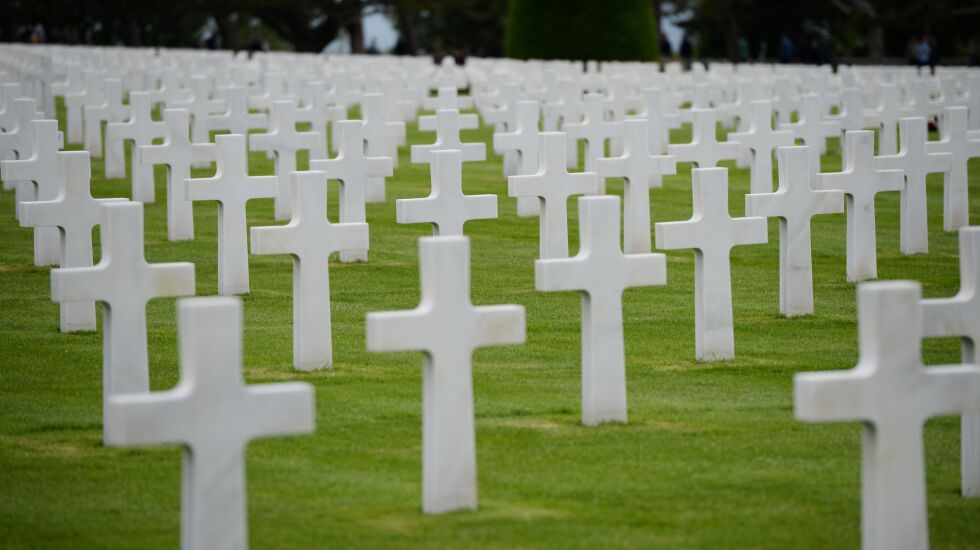
For 100 years, the American Battle Monuments Commission has not only served as the guardian of America’s military burial grounds and memorials abroad, but it has created permanent places of welcome for loved ones to mourn and pay respects.
Congress established the commission after World War I. That global conflict took the lives of so many American service members — nearly 75,000 — that the government initiated the practice of burying the fallen overseas, with their loved one’s permission. Once the fallen were laid to rest, the government devoted four years to sponsoring Gold Star pilgrimages that brought thousands of family members to their veterans’ distant grave sites.
Today, the commission is the caretaker of 26 burial grounds and 32 monuments and memorials on five continents. The centennial anniversary of our nation maintaining these final resting places is a moment for us to recognize.
While many of the more than 100,000 veterans buried at ABMC’s sites passed away generations ago, untold millions of Americans have family connections to them today. The commission’s online burial registry finds that 11,520 of those honored at their sites entered the military from Illinois.
‘Sacrifice was not in vain’
In June 1931, one of the ships carrying Gold Star wives and mothers was greeted by Gen. John J. Pershing, commander of the American Expeditionary Forces during World War I. He told them in addition to the sadness they would assuredly feel seeing the burial grounds, they would also realize “when they looked out over the white crosses of the cemeteries where their sons and husbands lie, that the sacrifice was not in vain, and that their memories would be tenderly cherished down through the years.”
Pershing’s words describe the timeless emotions of Gold Star spouses. While I lost my late husband, Lt. (SEAL) Brendan Looney, in a helicopter crash in Afghanistan nearly 80 years after the general’s remarks, I felt the feelings he described. Like anyone who has lost a loved one, Gold Star families visit our loved one’s grave site to grieve and reflect on his or her life. At the same time, because they died in service to our country, we also hope their graves keep their memories alive.
We want future generations to remember their sacrifices as the price of our freedom. We hope they see our loved ones as symbols of American values, at their best.
The respectful and pristine settings of these sites should also be a point of pride for our nation. The commission’s cemeteries stretch across peaceful, idyllic landscapes. The sites are adorned with elegant, inspiring art and architecture. Thousands of white stone grave markers are lined in exact rows, giving each individual a dignified resting place and creating a breathtaking picture of their collective sacrifice.
The sites also provide our host nations with a place to honor the Americans who sacrificed for their liberty. Last year, more than 2.9 million people visited commission sites. Many of those visitors were from the international community. Local families have also adopted grave sites over the years, so the service member’s loved ones would know someone was regularly visiting and tending to their plots. In some cases, these adopted grave sites have been passed down from generation to generation.
Ultimately, whether our service members died for a greater purpose is up to those of us who live on. Archibald MacLeish, who was born just outside of Chicago in 1892 and volunteered as an ambulance driver and field artillery officer during World War I, captured that sentiment in his poem, “The Young Dead Soldiers Do Not Speak.” A verse of that poem is inscribed on the commission’s World War I Memorial in Washington, D.C.
It reads:
Whether our lives and our deaths were for peace and a new hope
Or for nothing, we cannot say, it is you who must say this
They say we leave you our deaths, give them their meaning
We were young, they say, we have died, remember us.
The commission’s century of commitment to the final resting places of our fallen would, I believe, bring comfort to the women aboard those first Gold Star pilgrimages. In those times of grief, Gold Star families held onto many sources of strength, including those described by Pershing and that live on through the commission’s mission — their loved ones did not die in vain and their memories would be forever cherished.
Amy Looney Heffernan has been a presidentially appointed commissioner of the American Battle Monuments Commission since 2021. She is a Gold Star wife who lives in Lemont and is also vice president of the Travis Manion Foundation, which serves veterans and families of the fallen.
The Sun-Times welcomes letters to the editor and op-eds. See our guidelines.
The views and opinions expressed by contributors are their own and do not necessarily reflect those of the Chicago Sun-Times or any of its affiliates.







